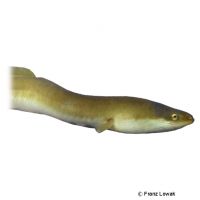European Eel (Anguilla anguilla)
| European Eel Anguilla anguilla | |
|---|---|
| Name | European Eel |
| Name Lat. | Anguilla anguilla |
| Family | Freshwater Eels |
| Family lat. | Anguillidae |
| Order | Eels & Morays |
| Order lat. | Anguilliformes |
| Origin | Europe |
| Habitat | Rivers, lakes |
| Diet | Carnivore |
| pH | 6.5-8.0 |
| Behavior | Semi-aggressive |
| Keeping | Individual, group |
| Care Level | Easy |
| Reproduction | Egg scatterer |
| Breeding | None reported |
| Life Span | 10-15 years |
| Protection | CITES Appendix II; EU Annex B |
| Metric Units | |
| Size | 50 cm |
| Temperature | 4-22 °C |
| Hardness | < 25 °dH |
| Aquarium | Pond |
| US Units | |
| Size | 20" |
| Temperature | 39-72 °F |
| Hardness | < 445 ppm |
| Aquarium | Pond |
Distribution and habitat
European eels are widely distributed in inland waters of Europe and Asia Minor, as well as in the North Sea, the Baltic Sea, the Mediterranean Sea and the Black Sea. They live mainly in freshwater, where they are found in rivers, streams and lakes with soft, muddy bottoms and spend the daytime hidden among plants or in the bottom
Maintenance
They need ponds with dense riparian planting, roots and stones that provide plenty of hiding places. A soft substrate in which they can burrow and subdued light (floating plants) is ideal
No ammonia, ammonium and nitrite should be detectable, the nitrate value should not exceed 100 mg/l. To ensure the water quality and oxygen content should not be missing a filter adapted to the water volume.
Diet
They are nocturnal predators that feed in nature on insects, crustaceans, worms, fish spawn and small fish. The food supply consists of a commercial dry food (granules, pellets) for pond fish, supplemented with small crustaceans, fish spawn, insect larvae, fish and shellfish, which is easily accepted even in frozen form, as well as earthworms, meal beetle larvae and snails.
Regular and varied feeding promotes health and increases resistance.
Behaviour and compatibility
Juveniles form large schools. With increasing age they become predatory loners that cannot be socialized with small pond fish
In principle, only mutually compatible fish species with similar requirements for water quality and water temperature may be socialized.
Reproduction and breeding
The females grow much larger than the males.
They are catadromous migratory fish that return to the sea to spawn. European eels migrate over 5,000 km to the Sargasso Sea, near the Bahamas, spawn at great depths, and then die. The eel larvae hatch in the Atlantic, reach the European coast after about 2 years as about 7 cm "glass eels" and migrate upstream at night in large shoals ("steigaal" or "yellow eel"). At the end of their growth phase, 6-12 years for males and 9-20 years for females, they become sexually mature and migrate back to the sea as "silver eels"
Species protection
Species protection: WA Appendix II; EU Appendix B. The proof of purchase is the required proof of origin for the animal. Please keep it safe! Your pet store will be happy to provide you with further information.
Important
They can meet half of their oxygen requirements through their skin, leave the water for short periods of time, and thus travel small distances over (wet) land.
The water temperature should not exceed 20-22 °C. At temperatures below 8 °C, the metabolism of European eels slows down and little food is accepted. In spring, with rising temperatures, feeding can slowly be resumed. Feeding may also be necessary during prolonged warm periods in winter. The well-being of the fish should be checked regularly. A regular partial water change, according to the pond size is recommended, even if the pollutant load has not yet reached the upper limit. Sudden changes in water quality should be avoided. Newly introduced fish must be accustomed slowly to the water in the pond or aquarium
Further literature can be found in your pet store.
References
Text: Werner Winter; Image: Franz Lowak
Source: BMELV (1998): Tierschutzgutachten - Haltung von Zierfischen (Süßwasser); RIEHL & BAENSCH (2006): Aquarien Atlas Bd. 3, Mergus Verlag; ENGELMANN (2005): Zootierhaltung - Tiere in menschlicher Obhut: Fische; Harri Deutsch Verlag
- Gemäß § 21 Abs. 5 Tierschutzgesetz idgF
